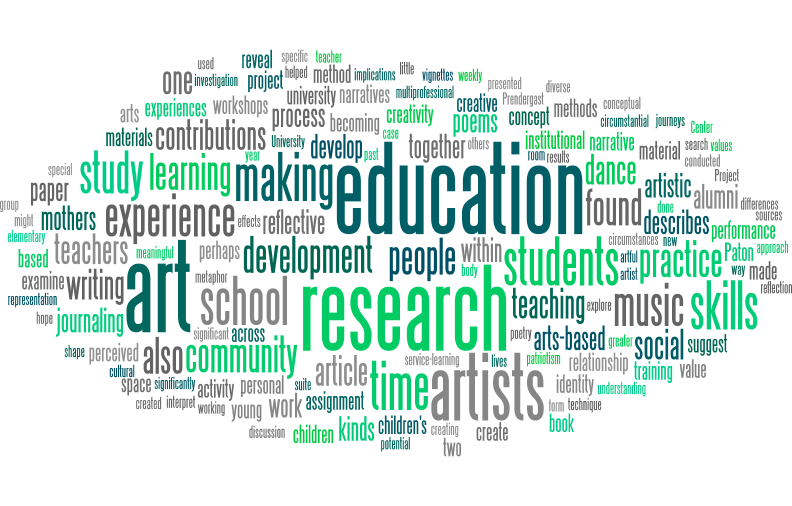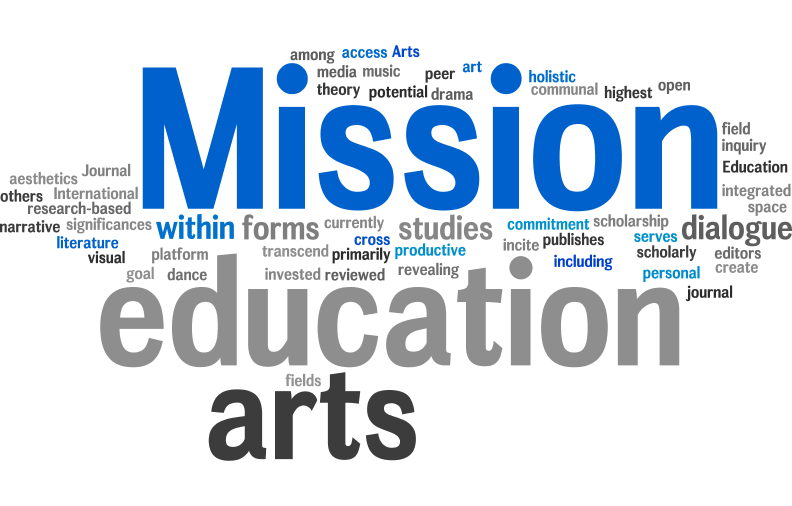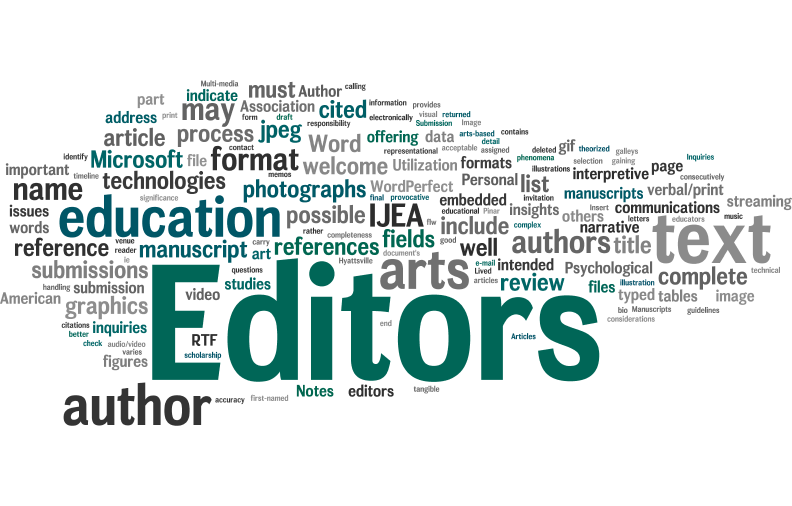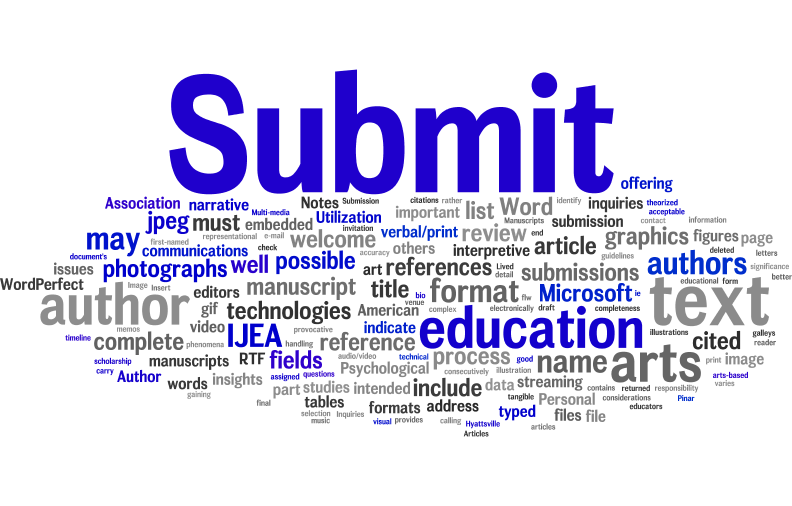2012 Volume 13
Articles and Abstracts

Articles
Volume 13 Number 1: Nevanen, S., Juvonen, A., & Ruismäki, H. Art education as multiprofessional collaboration.
In this article we explore the realisation of an art education project as multiprofessional cooperation. The multiprofessional collaboration pair in this study consisted of an artist working together with a teacher. This resulted in activities, which all actors, artists, teachers and administrators saw to be at an especially high level, both artistically and to the practice of teaching. Actually they all thought that the targets, which were set to the project, were clearly surpassed. At its best this working method connected artistic work with the pedagogic knowledge and experience of the children's group work. The work required common planning, flexibility from the traditional methods and culture together with a long-lasting timeframe, (1-2.5 year per each of the sub projects), which made it possible to try to develop new methods. In setting the aims and evaluating the results, the artist's highlighted the artistic significance, while the teachers focused on the instrumental values of art. In the end, both teachers and artists were satisfied with the results.
Volume 13 Number 2: Sanders-Bustle, L. Exploring narrative retellings to better understand the intricacies of service-Learning.
In this manuscript, the word "circumstances" serves as a conceptual lens through which to examine reflective vignettes of one university art educator and two art education undergraduates written in response to service-learning experiences at a local outreach Center for the homeless. Experiences included the design and teaching of art workshops to Outreach Center clients and the organization and exhibition of resulting artworks titled, circumSTANCES. The concepts, communal stance and shared circumstantial space are introduced and developed within the larger body of service-learning pedagogy. Participants' short narratives or vignettes are represented and examined to reveal the intracacies of circumstantial experience which include roles played, conflicts encountered, the emergence of communal stance, and actions taken.
Volume 13 Number 3: Thorne, M. M. The Destinee project: Shaping meaning through narratives.
Using narrative method in the form of journaling has the power to shape identity and relationships between teachers and students. This article reflects on such journaling and the process of writing poetry to create a space of understanding between two very different people who found themselves in the relationship of teacher and student. "The Destinee Project" is a collection of poetry based on my journaling and narrative inquiry as I seek to deal with the experience of transition of my school and the struggles of my students. In the past ten years, our school has transitioned from an affluent homogenous group to an extremely diverse urban Title I school. My interaction with Destinee and my reflection on our experience together has helped shape my approach to students and parents. I hope to inspire others to engage in journaling and experience the efficacy of writing about classroom experiences.
Volume 13 Number 4: Freeman, J. Drama at a time of crisis: Actor training, performance study and the creative workplace.
At a time when our graduates are facing a world of ever more perplexing change and when funding for university arts is coming increasingly under threat, this paper is perhaps a means of reminding ourselves of our subject's strength ... of its value to university curricula and its clear contribution to the international creative economies. In this sense, the following paragraphs are as much about sharing with colleagues what it is that the study of performance does well as with making suggestions for enhancement. Notwithstanding this, the article concludes by suggesting ways in which deep approach learning can be applied to the study of performance, and its argument throughout is that performance study and actor training are weakened by boutique borrowing and the making of false promise.
Volume 13 Number 5: Miller, A. and Lambert, A. Comparing skills and competencies for high school, undergraduate, and graduate arts alumni.
This study investigates preliminary findings from the 2009 administration of the Strategic National Arts Alumni Project (SNAAP), comparing alumni perceptions of institutional contributions to the development of skills and competencies across high school, undergraduate, and graduate arts training programs. Responses from 4,031 arts alumni suggest significant differences between perceived skill development contributions in the areas of artistic technique, communication skills, social skills, personal growth, research skills, and technology skills. High school alumni report significantly greater perceived institutional contributions to their development of artistic technique, communication skills, social skills, and personal growth. Graduate alumni report significantly greater perceived institutional contributions to their development of research and technological skills. Potential experiential and curricular reasons for these differences are discussed.
Volume 13 Number 6: Malin, H. Creating a children's art world: Negotiating participation, identity, and meaning in the elementary school art room.
Art making has been theorized as a way for children to develop the capacity to participate in social and cultural transformation. Yet, little research has been done to examine the role of art making in children's development as participants in society. This study used ethnographic methods to investigate children's art making in elementary school. Observations took place in one elementary school art room for one academic year. Children were interviewed, in small groups and individually, about their art making activity. In the art room, the children were found to be creating a community of art practice. This community of practice had implications for how the children were developing as participants within the community, and for how they made their school art making into personally meaningful activity.
Volume 13 Number 7: Countryman, J. Learning posts: A pedagogical experiment with undergraduate music education majors.
This article describes the effects of a year-long reflective writing assignment - weekly Learning Posts - designed for students in an undergraduate music education course. I created this assignment to cause students to regularly interrogate the teaching and learning they experience in their own daily lives. This study's research question emerged from critical reflection at the intersection of practice and theory. Does a weekly requirement to describe and interpret a personal learning experience encourage, over time, instances of significant learning (Fink, 2003). My data sources consist of regular entries in my teaching journal monitoring the assignment and post-course interviews conducted with four students. I identify the positive potential of Learning Posts, improvements to enhance their effectiveness and broader issues concerning the reflective writing we assign music education students. The concept of self-authorship confirms the importance of reflective writing for young adults and the notion of threshold concepts contributes a potential framing device.
Volume 13 Number 8: Chappell, K., Craft, A. R., Rolfe, L., & Jobbins, V. Humanizing creativity: Valuing our journeys of becoming.
In this paper we explore the relationship between creativity and identity in dance education. We consider how, when creating dance, young people can go on a 'journey of becoming'; how in the process of making dance, they are also being made. We draw on the Dance Partners for Creativity research, a qualitative in depth study of creative partnership practice in secondary level English dance education, to develop these ideas. Understanding the journeys of becoming within this research has helped us to refine the concept of 'humanising creativity'. This is an active process of change guided by compassion and shared values. It comes from people engaging in collaborative thinking and joint action to imaginatively develop new ideas which are valuable to them and their community. The research and conceptual development leads us to suggest that educationally, we might better recognise and value the journeys of becoming at the heart of humanising creativity, not only within dance but perhaps more widely.
Volume 13 Number 9: Denmead, T. & Hickman, R. Viscerality and slowliness: An anatomy of artists' pedagogies of material and time.
This paper explores community artists' pedagogies in relation to time and material. Thirteen unstructured interviews were conducted with eight artists under the auspices of an organisation that facilitated community-based workshops in Cambridgeshire, UK throughout 2011 and 2012. Concepts salient to the artists emerged, and six of the eight artists were observed facilitating twenty workshops across five sites. We found that the artists create conditions for open-ended enquiry across five dimensions: space, time, material, body, and language. This paper focuses on one of these dimensions - that of material, with reference to one other, that of time. We discuss artists' criteria for workshop materials, including simplicity, slippage, immediacy, richness, and ephemerality. We examine how the artists presented a 'limited palette' of select materials, though provided each in abundance. And we interpret the artists using materials to facilitate what they described as slowliness - an immersive, pleasure state free from past prescription and future expectation.
Lived Aesthetic Inquries
Volume 13 Lived Aesthetic Inquiry 1: Valle, J, & Connor D. Becoming theatrical: Performing narrative research, staging visual representation.
This article describes a collaborative project among the author of a book about mothers and special education (based on a collection of oral narratives of mothers who represent diverse generations, races, and social classes), a playwright, and an artist. Together, they created a theatrical and visual staging of the author's narrative research. The staged reading included a post-performance discussion with the cast, two mothers whose narratives appear in the work, the co-authors and the audience. This discussion indicated a positive response to this alternative form of research representation and generated meaningful dialogue about mothers' experiences with special education and its unintended consequences in the lives of their families.
Interludes
Volume 13 Interlude 1: Greenwood, J. Arts-based Research: Weaving Magic and Meaning.
What kinds of things do we research when we use arts-based research? And when we apply arts-based research to educational contexts, what kinds of contributions to the scholarship of learning and teaching can we make?
Taking as its basis three case studies in which art processes were used to investigate culture and identity, this essay examines the kinds of questions arts-based research might seek to answer. At the same time as it acknowledges the value of the less definable and often holistic kinds of knowing that may result through the use of art tools and aesthetic analysis, it also argues for the usefulness of strategic focus on specific frames of investigation and specific outcomes. It further examines the relationship between arts-based research and learning.
Volume 13 Interlude 2: Prendergast, M. (2012). Education and/as Art: A Found Poetry Suite.
Embracing metaphor as method (Prendergast, 2005; see also Prendergast, 2006a, 2006b, 2008a), which I suggest is a key characteristic of thinking poetically and doing poetic inquiry, is the process conveyed in this suite of found poems. The investigation began with a cross-disciplinary scholarly database search on the term "education as art" that asked: How has education been conceived as artful over time? This search led to (sadly but unsurprisingly) very few sources that explicitly employ this metaphor. However, what was discovered was powerful enough to warrant interpretation through poetic transcription and representation in a suite of found poems. These poems reveal the frustration, even rage, of those who wish to re-vision education as artful. They also reveal hopeful (perhaps utopian) views of what education could look like if re-conceived as the enculturation of artists. These found poems were presented as part of a keynote lecture to Ph.D. education students at the University of Minho, Braga, Portugal in April of 2011.
Book Reviews
Volume 13 Review 1: Björk, C. (2012). Lifemusic: Connecting People to Time: A Review Essay.
Book Reviewed: Paton, R. (2011). Lifemusic: Connecting People to Time. Dorset, Great Britain: Archive Publishing. ISBN 9781906289140.
Rod Paton is a composer, horn player specializing in jazz and improvisation, and senior lecturer at the University of Chichester. He is also a community musician and tireless defender of everyone's right to music regardless of training or background. In Lifemusic: Connecting people to time, Paton describes the philosophy and practice of his concept based on creative improvisation and a participatory ideal. Following Christopher Small's clarion call (in Stevens, 1985) to "give back to people the music that belongs to them", Paton makes a case against what he describes as hegemonies that are dependent on experts who create, control and mediate musical activity, reducing others to passive consumers. He agrees fully with Small about the problematic social implications of musicianship and music education under these circumstances, notably cultural imperialism and the way practices intimidate the uninitiated by demanding normative perfection.
Volume 13 Review 2: Sloboda, J. (2012). Patriotism and Nationalism in Music Education: A Review Essay.
Book Reviewed: Hebert, D., & Kertz-Welzel, A. (2012). Patriotism and nationalism in music education. Farnham, UK: Ashgate. ISBN 978-1-4094-3080-3.
This book is a brave first attempt to bring together information and arguments relevant to an understanding of how patriotism and nationalism intersect with music education. As such, it both stands as a "must read" resource for anyone interested in this topic, and also as an indication of how little we know in depth about the effects of patriotism on music teachers and the young people they teach. There are many empirical studies that are begging to be done, and I hope this book stimulates some researchers to undertake them.



